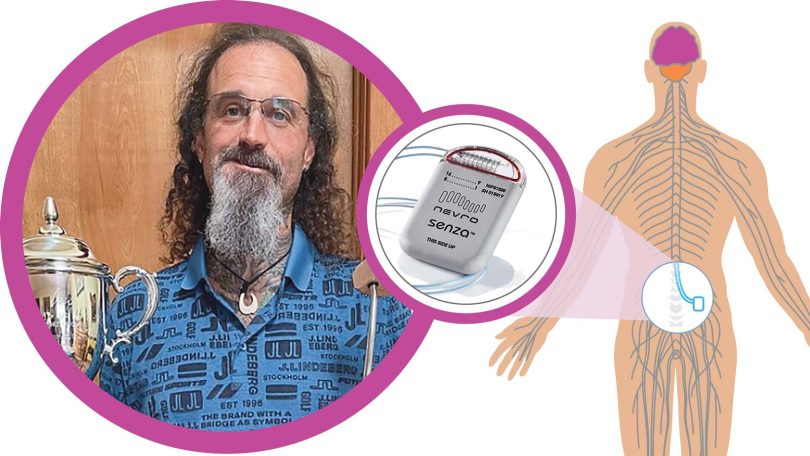If you don’t have back pain yourself, you probably know someone who does. According to the Centers for Disease Control and Prevention, acute low back pain is one of the most commonly reported types of pain and is responsible for more disability globally than any other condition. Few understand this better than Aron, a former high school athlete who enjoyed riding four-wheelers and being an active person before he was hampered by chronic back pain.
Aron experienced constant and sharp pain, plus numbness and tingling in his legs, and sought relief which included 10 different back surgeries over 17 years. “I looked like a healthy 6´2´´ man on the outside, but on the inside, I was in so much pain,” he says. “It’s hard to explain the emotional strain.”
Fortunately, Aron was introduced to UHS orthopedic surgeon Matthew Bennett, MD, who included him in a trial of the Nervo HFX spinal cord simulation implant. This device interrupts pain by sending electrical impulses to nerves, calming them and reducing the pain signals sent to the brain. The device changed Aron’s life, allowing him to finally get a full night’s sleep, get off of opioid pain relievers and reduce his pain by 90%.
“HFX has been a blessing,” he explains. “I can golf, cut firewood and travel again. It’s had a major impact on my quality of life. I’d do it again in a heartbeat.”
A Team-Based Approach
Creating stories like Aron’s is what the providers in UHS Spine Care & Pain Relief strive for. The way they reach these positive outcomes for patients is through a multidisciplinary approach to care that involves collaboration among many different types of practitioners.
“We offer a team-based approach that is comprehensive in nature,” says Prakash Ramanathan, director of Clinical Operations & Neuroscience Services at UHS. “This includes everything from conservative therapies, such as physical therapy, chiropractic or medical management, to interventional care with injections or other procedures and, as a last resort, surgical operations.”
Focused communication between these teams is key to providing the best care, Dr. Bennett explains.
“We’re all cross-pollinated,” he says. “The orthopedic surgeon is understanding what the physical therapist is doing. The chiropractor is understanding when it’s the best time to do a procedure. We’re understanding how we all fit together—we’re here to protect the community’s well-being. Whoever on our team has the right skills for that patient, we use their skills to get our patients better.”
Curating Care for Every Patient
Both Mr. Ramanathan and Dr. Bennett explain that this multidisciplinary approach starts with the patient. Ensuring that every provider who works with a patient understands their case helps provide that patient with the best individualized care possible.
“I think the most important thing we do is that we listen,” says Dr. Bennett. “We listen to what’s really going on and we know that each patient is different and brings a unique set of problems to the table.”
Dr. Bennett points to a recent patient the team worked with as an example. The patient came into Dr. Bennett’s office with chronic back pain and muscle tightness. Dr. Bennett brought him to the integrative spine group, which included chiropractor Zachary Secoolish, DC, and physical therapist Kelly Buchsbaum, PT, MSPT, and they all looked at the patient’s issues together.
“Kelly is a golf pro, and this patient is an avid golfer. We found out there are some changes we could make to his golf swing that are going to make a big difference,” Dr. Bennett explains. “We brought him over to the performance gym and watched everything he was doing, breaking it down and figuring out what went wrong. We helped this patient figure out how he can stay active and stay fit while also avoiding this pain he experienced.”
Providing Relief
Patients who come to UHS Spine Care & Pain Relief with back pain are often in a difficult place, physically, mentally and emotionally. Pain can control your life in many ways. Giving relief to this strain is core to the mission of UHS providers.
“There are so many facets of daily living that spine injury or illness can affect,” says Mr. Ramanathan. “When we heal these patients, they can return to those normal functions that were affected. When we get patients better, back to their baseline, they are really thankful and appreciative of that.”
And the stories of patients like Aron make that clear. After being treated by Dr. Bennett and getting relief from debilitating pain, he was able to return to things he loved like coaching his daughter’s volleyball team. Echoing the experiences of the many patients UHS Spine Care & Pain Relief has successfully treated over the years, he says: “I’m enjoying life again!”
GET RELIEF
Learn more about UHS Spine Care & Pain Relief at nyuhs.org.




